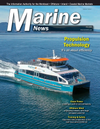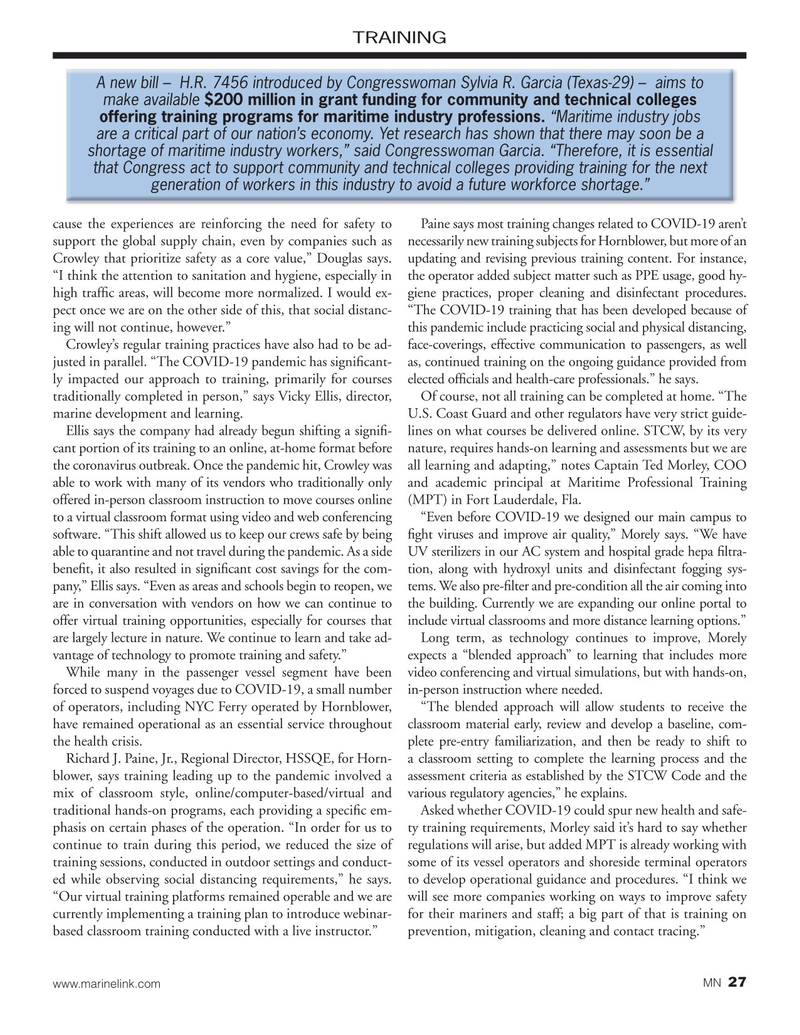
Page 27: of Marine News Magazine (July 2020)
Propulsion Technology
Read this page in Pdf, Flash or Html5 edition of July 2020 Marine News Magazine
TRAINING
A new bill – H.R. 7456 introduced by Congresswoman Sylvia R. Garcia (Texas-29) – aims to make available $200 million in grant funding for community and technical colleges offering training programs for maritime industry professions. “Maritime industry jobs are a critical part of our nation’s economy. Yet research has shown that there may soon be a shortage of maritime industry workers,” said Congresswoman Garcia. “Therefore, it is essential that Congress act to support community and technical colleges providing training for the next generation of workers in this industry to avoid a future workforce shortage.” cause the experiences are reinforcing the need for safety to Paine says most training changes related to COVID-19 aren’t support the global supply chain, even by companies such as necessarily new training subjects for Hornblower, but more of an
Crowley that prioritize safety as a core value,” Douglas says. updating and revising previous training content. For instance, “I think the attention to sanitation and hygiene, especially in the operator added subject matter such as PPE usage, good hy- high traf?c areas, will become more normalized. I would ex- giene practices, proper cleaning and disinfectant procedures. pect once we are on the other side of this, that social distanc- “The COVID-19 training that has been developed because of ing will not continue, however.” this pandemic include practicing social and physical distancing,
Crowley’s regular training practices have also had to be ad- face-coverings, effective communication to passengers, as well justed in parallel. “The COVID-19 pandemic has signi?cant- as, continued training on the ongoing guidance provided from ly impacted our approach to training, primarily for courses elected of?cials and health-care professionals.” he says.
traditionally completed in person,” says Vicky Ellis, director, Of course, not all training can be completed at home. “The marine development and learning. U.S. Coast Guard and other regulators have very strict guide-
Ellis says the company had already begun shifting a signi?- lines on what courses be delivered online. STCW, by its very cant portion of its training to an online, at-home format before nature, requires hands-on learning and assessments but we are the coronavirus outbreak. Once the pandemic hit, Crowley was all learning and adapting,” notes Captain Ted Morley, COO able to work with many of its vendors who traditionally only and academic principal at Maritime Professional Training offered in-person classroom instruction to move courses online (MPT) in Fort Lauderdale, Fla.
to a virtual classroom format using video and web conferencing “Even before COVID-19 we designed our main campus to software. “This shift allowed us to keep our crews safe by being ?ght viruses and improve air quality,” Morely says. “We have able to quarantine and not travel during the pandemic. As a side UV sterilizers in our AC system and hospital grade hepa ?ltra- bene?t, it also resulted in signi?cant cost savings for the com- tion, along with hydroxyl units and disinfectant fogging sys- pany,” Ellis says. “Even as areas and schools begin to reopen, we tems. We also pre-?lter and pre-condition all the air coming into are in conversation with vendors on how we can continue to the building. Currently we are expanding our online portal to offer virtual training opportunities, especially for courses that include virtual classrooms and more distance learning options.” are largely lecture in nature. We continue to learn and take ad- Long term, as technology continues to improve, Morely vantage of technology to promote training and safety.” expects a “blended approach” to learning that includes more
While many in the passenger vessel segment have been video conferencing and virtual simulations, but with hands-on, forced to suspend voyages due to COVID-19, a small number in-person instruction where needed. of operators, including NYC Ferry operated by Hornblower, “The blended approach will allow students to receive the have remained operational as an essential service throughout classroom material early, review and develop a baseline, com- the health crisis. plete pre-entry familiarization, and then be ready to shift to
Richard J. Paine, Jr., Regional Director, HSSQE, for Horn- a classroom setting to complete the learning process and the blower, says training leading up to the pandemic involved a assessment criteria as established by the STCW Code and the mix of classroom style, online/computer-based/virtual and various regulatory agencies,” he explains.
traditional hands-on programs, each providing a speci?c em- Asked whether COVID-19 could spur new health and safe- phasis on certain phases of the operation. “In order for us to ty training requirements, Morley said it’s hard to say whether continue to train during this period, we reduced the size of regulations will arise, but added MPT is already working with training sessions, conducted in outdoor settings and conduct- some of its vessel operators and shoreside terminal operators ed while observing social distancing requirements,” he says. to develop operational guidance and procedures. “I think we “Our virtual training platforms remained operable and we are will see more companies working on ways to improve safety currently implementing a training plan to introduce webinar- for their mariners and staff; a big part of that is training on based classroom training conducted with a live instructor.” prevention, mitigation, cleaning and contact tracing.” 27 www.marinelink.com MN

 26
26

 28
28
